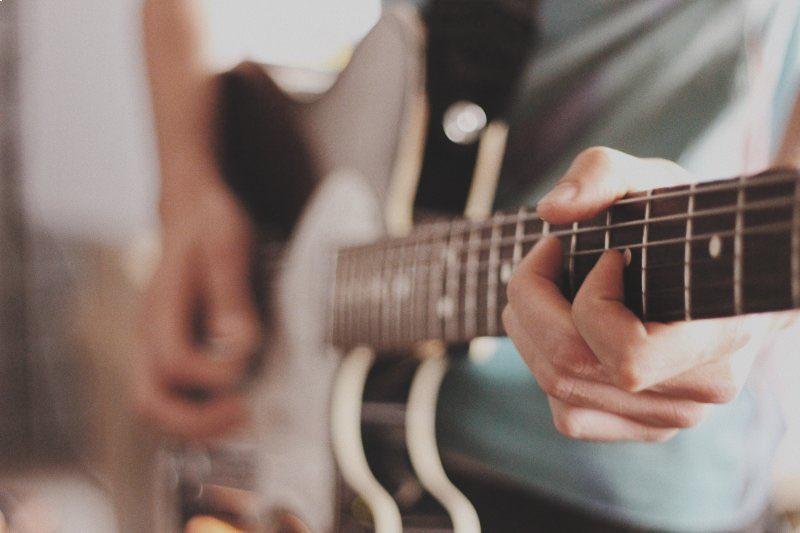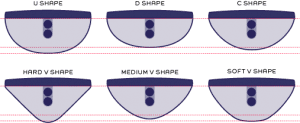The modern guitar that we know and love today has existed for over 150 years. The great luthier, Antonio de Torres Jurado invented the first classical guitar in 1852, and it is his legendary creation that would go on to influence every single guitar on the market today. One of the smallest, but perhaps most important, evolutions in guitar building has been the shape of the guitar’s neck.
The guitar’s neck is the carved piece of wood that protrudes from the body. And it is where we place our fretting hands to play notes. While classical guitars stick to one specific shape, the introduction of the electric guitar brought forth new guitar neck shapes. These neck shapes served different purposes for the guitarist.
Having different guitar neck shapes (also called neck profiles) allows for different playing styles to be comfortable, as well as appeal to the different body types and hand anatomy of all guitarists. It is crucial to find an instrument that feels the most comfortable to you; otherwise you won’t enjoy your practice! Here are the four most common neck shape categories and their pros and cons. This will help you decide which neck shape is best for your style of playing…
All of the names of these neck shapes come from the appearance of the neck when looked at as a cross section.
D Shape
The D Shape neck is the original shape profile for classical and flamenco guitars. This shape is commonly mistaken for the C Shape Profile, which we will look at later in this list. The D Shape has edges that are straighter before it curves around the neck and flattens in the middle. This shape is comfortable for playing faster music as well as doing string crosses efficiently. When it comes to the wider necks of classical and flamenco guitars, some players find this shape to be uncomfortable or thick. This shape stuck around for the first 100 years of the guitar’s history. However, the guitar had to start somewhere, and this is the shape I am used to.
U Shape
The U Shape neck is also commonly referred to as the “Baseball Bat Shape” due to its thickness. The U shape is the largest sized neck and it is great for players with bigger hands. Some players who have smaller hands might find the U Shape beneficial if they keep their thumbs directly on the back or sides of the neck. This neck came around during the early 1950’s during the height of the electric guitar frenzy. At that time, companies like Fender and Les Paul were innovating new guitars to revolutionize the market. An artist who utilized a U Shape neck guitar was the great blues guitarist, B.B. King. As the 1950’s went on, we were then introduced to different styles that branched off the U Shape; the Soft V and Hard V.
V Shape
As the name implies, the V Shape neck is very angled, so it appears to look like the letter V. However, just because it is called a V Shape neck does not mean it is a sharp V like what we write on a piece of paper; the neck is still curved like the rest but the middle comes to rounded point. There are two common variations of this shape known as the Soft V and the Hard V. The Hard V looks more like a letter V and it is much more obviously angled. The Soft V is not as angled, and the neck flattens more compared to the Hard V.
These variations were invented in the mid-1950’s after the U Shape became popular. V Shapes are considered “old-school” these days. However, they work great for guitarists who would place their thumb over the fretboard to play bass notes.
C Shape
The C Shape neck is very similar in appearance to the D Shape neck mentioned previously. The C Shape is the most common shape on modern guitars and it is the most versatile between styles. This profile was developed during the 1960’s, and it quickly became the standard for most guitars today. Jimi Hendrix was best known for playing a C Shape Stratocaster. The C shape has an even curve that makes the player’s grip secure and comfortable.
This neck shape is flatter and skinnier than the D Shape, which many people find more relaxing on their hands. Each brand of guitar might also determine how flat they make their C Shape, so explore your options before buying.
It is also common to see “tapered necks”, which means the thickness of the neck gets thicker as you go down the neck. However, if you have hands that are larger than most people, you might not find the C Shape to be the most comfortable. It was the introduction of the C Shape that set the standard of the majority of guitars on the market for the past 60 years.
Find Your Neck!
While it does not affect the physical sound of the guitar, the choice of neck can drastically affect your ability and comfort while playing the guitar. I would not say that one shape is better than the other, as it is a matter of personal preference and stylistic choice.
I would say, if you are looking into getting a new guitar, you should first hold as many as you can at the music shop before buying. If you can play guitar already, try playing the same piece of music or riff on multiple guitars and pay attention to which neck is the most comfortable for you. If you have not started learning guitar yet, ask an employee to show you how to hold the guitar. This way, you can determine what guitar neck shapes work for you. I would much rather purchase a guitar with a comfortable neck than a guitar that has the best sound, but is painful to play!
Zach Deyo


